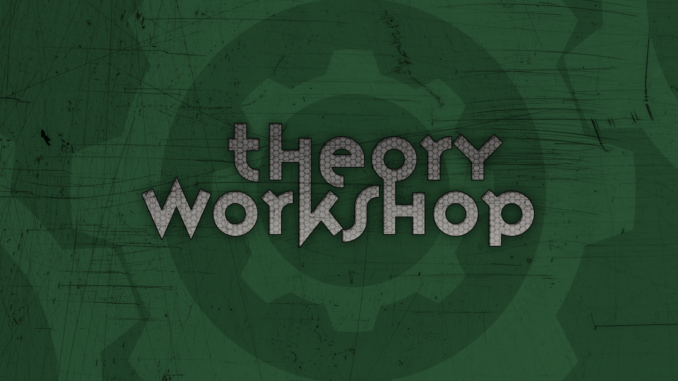
Our role in this episode of Theory Workshop, we will be exploring an expansion of a concept present by the developers of CCP’s Project Nova. Specifically, we will be discussing dropsuit progression and unlocking gear. Please bear in mind that this is simply an expansion of an idea that was presented by the developer and should be considered a starting point for a discussion and not a finalized concept.
Scope
The original discussion was CCP Rattati talking about dropsuit progression and the various stages the dropsuit goes through as it is upgraded. First and foremost, he emphasized that there is no “pass thru content” in that you will never unlock something that is ultimately made obsolete by unlocking a superior version of it. Every class has a single dropsuit that is instead augmented/upgraded over time to unlock additional fitting options, bonuses, and upgrades. So while upgrading the suit will make it objectively better than it was before you upgraded it, it is still the same suit. In a sense, this is to give an emotional attachment to the suit as you upgrade and improve it over time, rather than throwing it away once you unlock something better.
Secondly, the current plan is that all dropsuits are pre-fit when you first get them, much like the APEX suits from DUST. It is currently unclear how much you will be able to modify these fits initially, but the only modules you will have access to at this stage are the modules currently fit in the suit. The suit also has no bonuses at this stage. This is the Civilian level dropsuit.
Once enough experience has been gained from suit the suit in battle, it can be upgraded with ISK to a Tech I suit. (I understand that EVE uses a similar naming convention. Please note that there are some differences between what we will be describing for Nova and EVE, but the concepts are similar enough for the use of said terms to make sense.) As a player uses their Tech I dropsuit, it will unlock bonuses for the types of gear it has come pre-fit with that make sense for the general playstyle that class will use. Once a number of those bonuses have been unlocked, players will be able to upgrade their dropsuit to Tech II.
Tech II suits are more specialized, gaining bonuses that specifically pertain to the type of role they will be playing on the battlefield. Additionally, they will start to gain the ability to transfer the gear they have been pre-fit with to other classes. This means that in order to unlock other gear, players must play different classes and reach Tech II in order to gain access to that gear on any class. It is unclear if dropsuits need to be Tech II to receive transferred gear, or if Tech II is only to transfer gear, but any level of dropsuit can use transferred gear. Once a player has played long enough with a Tech II suit, it will be able to be upgraded to Tech III.
UPDATE: CCP Rattati provided some clarification regarding Tech II and sharing gear between classes. Dropsuits initially start with “Fixed” slots which cannot be fit with anything outside that class’s initial fit. At Tech II, those slots can be unlocked and converted to Omni slots. This allows the gear in that slot to be transferred to other classes, but it also allows you to fit gear from other classes in that slot. That being said, both classes must unlock Omni slots before they can trade gear between one another. For example, leveling an Assault to Tech II and unlocking the Fixed Shield Extender slot would allow the Shield Extender to be fit to other Classes. However, if I wanted to fit that shield extender to my Vanguard, I would first need to level Vanguard to Tech II and unlock an Omni slot to fit the Shield Extender in. As CCP Rattati put it “Both classes need to reach the same milestone”
Tech III dropsuits unlock a unique slot on the dropsuit that is used for Firmware. Firmware is a consumable item (we will discuss consumables at in a later article) that can modify a number of things about the dropsuit, but specifically focuses on changing they bonuses the suit receives. For example, firmware from a particular faction will overwrite the role bonuses the suit naturally has and give the suit different but more powerful bonuses that are in line with that faction’s design doctrine. Firmware will also overwrite the default SKIN that a dropsuit has with a unique faction SKIN (however fitting a SKIN module will overwrite the Firmware’s unique SKIN).
There is no separate skill tree that provides bonuses to multiple suits. Instead, all skills/bonuses are baked into the suits and gear unlocks come from within the progression of each dropsuit.
That is the general outline that CCP Rattati has provided for their current direction of the design. Now we will explore an expansion of that idea. Please bear in mind that this is simply an expansion of an idea that was presented by the developer and should be considered a starting point for a discussion and not a finalized concept.
 The SP System and General Progression
The SP System and General Progression
The SP system follows a simple design principle, if you use a piece of gear in battle you will gain SP for it. So for this concept, using a given dropsuit will earn you Dropsuit SP and using a particular piece of gear will earn you Gear SP unique to that type of gear. For example, using an Assault suit fit with a Shield Extender will give you Assault Dropsuit SP, as well as Shield Extender SP. These SP pools will be spent at various stages in the progression tree.
Generally speaking, Dropsuit SP is used to move “down” the tree and into higher Tech Levels, whereas Gear SP is used to unlock “side-grades” such as new bonuses for gear, variations of existing gear, and the ability to transfer gear to other dropsuits. Please note that each piece of gear has its own unique SP ( e.g. You can’t use Shield Extender SP to unlock Armor Plate Bonuses). ISK is also used in tandem with SP at every upgrade stage.
Civilian and Tech I
The Civilian level is what a new player will be exposed to first. It has no bonuses and a pre-fit set of modules in order to facilitate quick and easy access to battle with a reasonably useful fit as quickly as possible. Players should be able to upgrade out of Civilian fairly quickly, but it does provide an easily understandable baseline for new players.
As players move into Tech I, Dropsuit SP will continue to unlock more and more nodes as they work their way to Tech II. Each of these nodes will unlock unique bonuses for each type of gear fit the dropsuit. Once the first bonus of all the gear has been unlocked, the dropsuit is eligible to upgrade to Teach II. Players will generate SP for all types of gear they currently have fit, and that Gear SP can be spent on either unlocking additional bonuses for that gear, or for unlocking variations of that gear. This allows the players a degree of choice in what takes priority: Better Bonuses or More Variety. (Note: Additional Bonus and Variant unlocks are NOT required to upgrade the dropsuit to Tech II)
Below is a general layout for how Tech I progression would play out.
(Click the image for a higher resolution)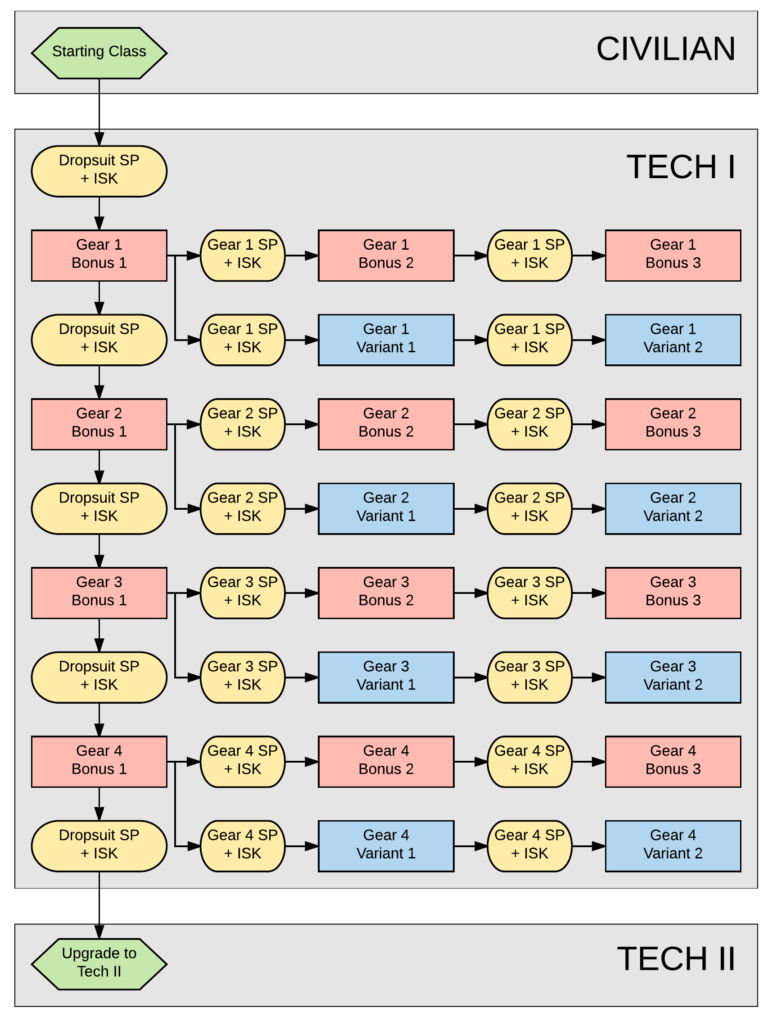
To give a more concrete example, let’s look at how this might look for an Assault class fit with Shield Extenders, Shield Booster, Capacitor Rechargers, and Damage Modifiers.
(Click the image for a higher resolution)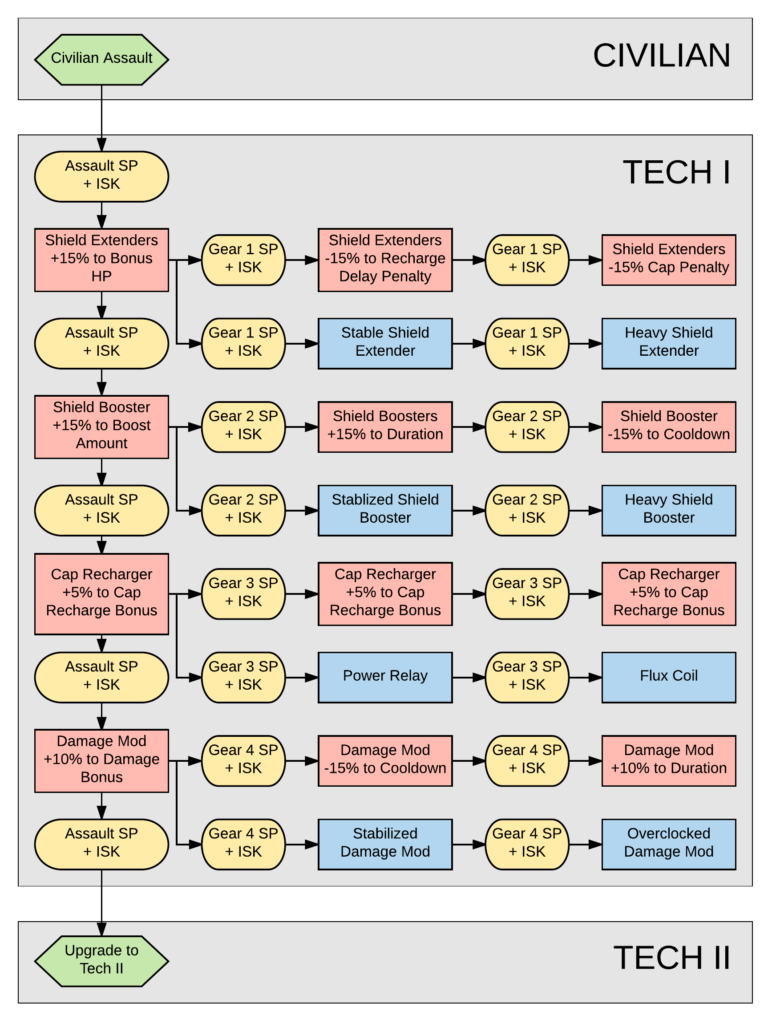
Remember that these bonuses are meant to provide basic skills such as survivability and damage output. More role specific bonuses are saved for Tech II.
Tech II
Tech II is when dropsuits start to really dial into their specialty, gaining powerful role-specific bonuses and the ability to transfer their modules to other classes. As with Tech I, Dropsuit SP is primarily used to unlock nodes and level up to the next Tech level. However, in this instance, each node unlocks class specific bonuses for the suit that directly support the role that class plays on the battlefield. Subsequently, this allows players to spend Gear SP to unlock the ability to transfer gear and variants to other classes. This could be tied to each node as depicted below, or alternatively unlock the ability as soon as the player upgrades to Tech II.
(Click the image for a higher resolution)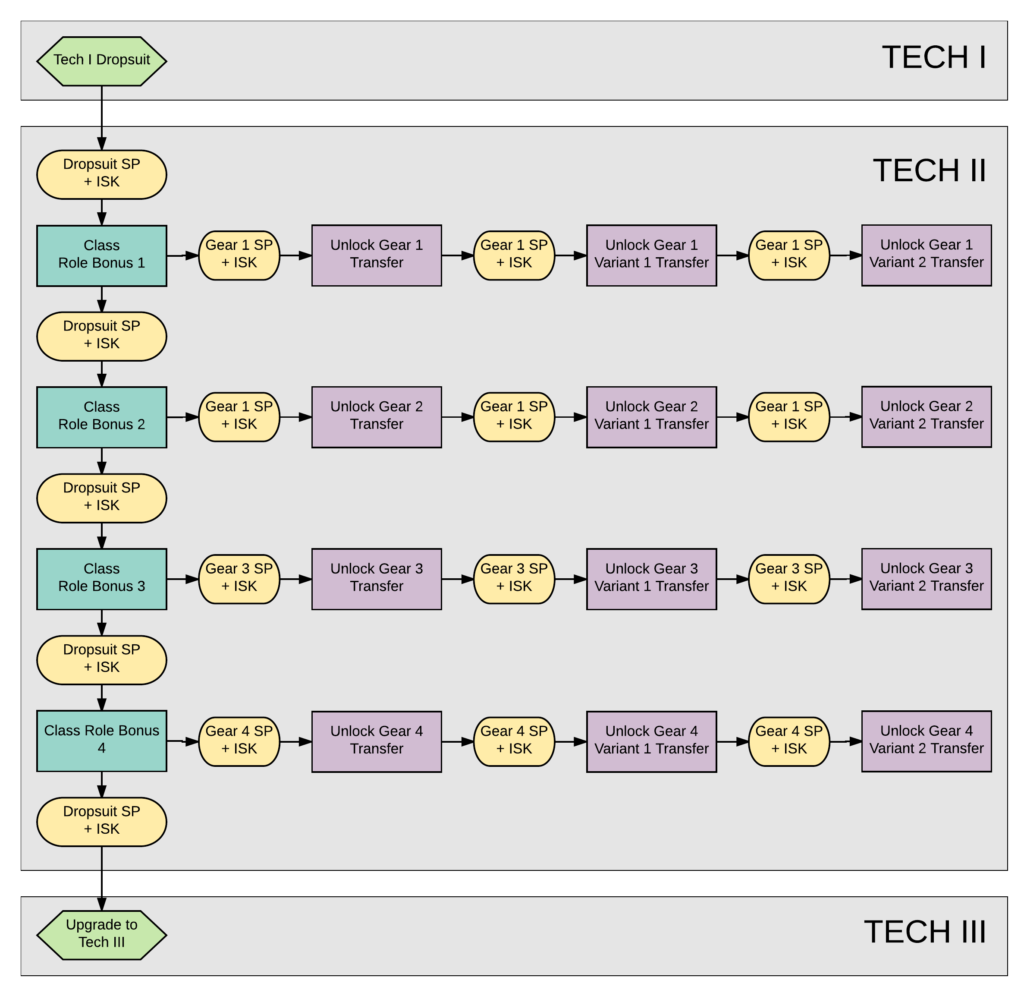
Now, let’s take a look at what this structure may look like for an Assault class dropsuit.
(Click the image for a higher resolution)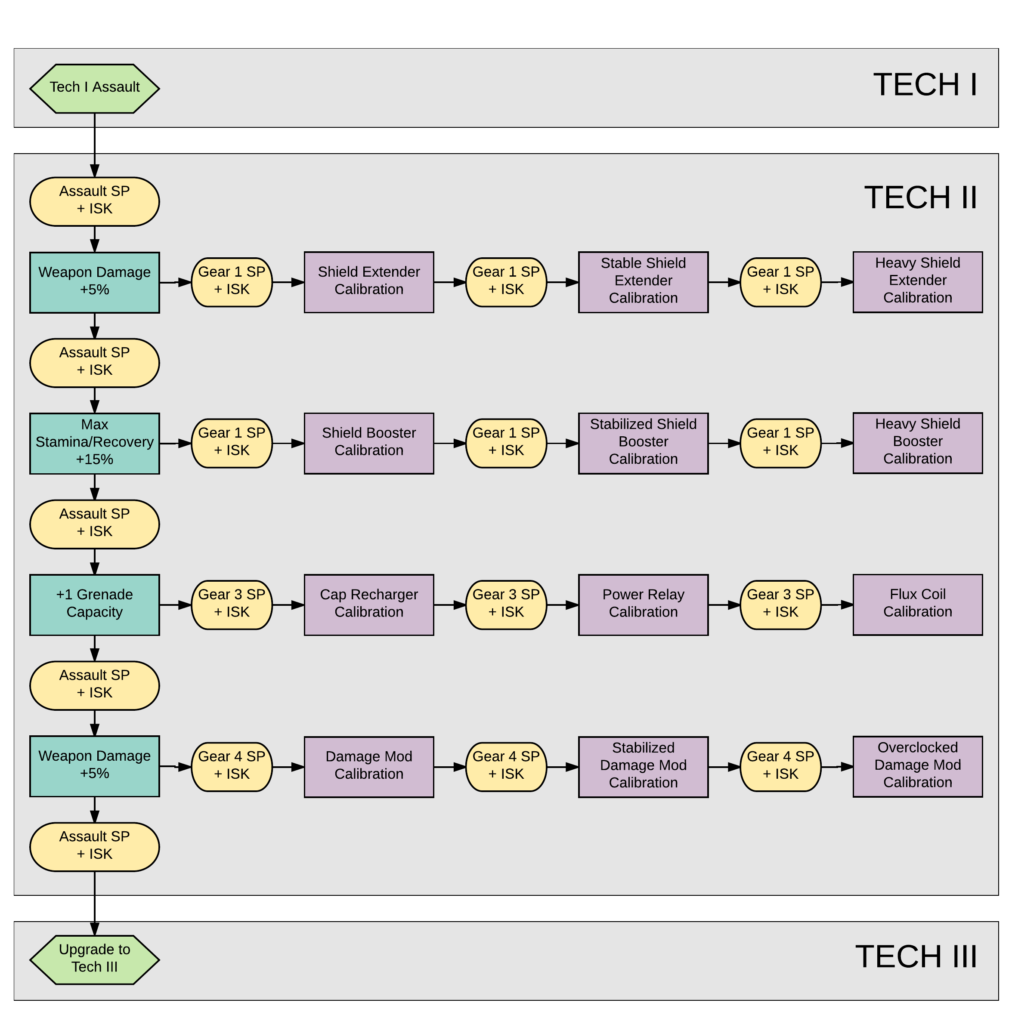
Note that both the skill to transfer a gear variant to another class as well as the unlock for that variant are necessary to use that gear in another class. For example, both the Power Relay Variant as well as Power Relay Calibration must be unlocked before Power Relays can be used on something like a Logistics.
Also, understand that bonuses associated with gear are tied to the dropsuit and not the gear itself. In the Assault example, Assaults unlock a +15% to Shield Extender HP bonus. So if a Shield Extender normally gives 100 Shield HP, the Assault would get 115 Shield HP. However if that same shield extender was transferred to a Logistics dropsuit, it would only receive 100 Shield HP.
However, these Gear Bonuses are meant to be somewhat broad in the modules they provide bonuses to and that some overlap may exist between classes. For example, a Vanguard may also come pre-fit with a Shield Extender, but the variants it unlocks may be different than the Shield Extender variants the Assault unlocks. If a Vanguard Shield Extender Variant is transferred to an Assault, it would still gain the full benefit of the Assault’s Shield Extender Bonus. This encourages players to play many different classes to unlock all possible modules and variants, as their primary class’s bonuses will still provide a benefit to certain variants only available on other classes.
Tech III
Tech 3 is designed to be an end-game dropsuit upgrade that allows players the ability the further tweak out their dropsuit performs in order to better fit the playstyle. The upgrade to Tech III simply unlocks the Firmware slot for the dropsuit. Firmware could do a number of things, but the primary purpose to temporarily overwrite and alter the Role Bonuses that the dropsuit in the Tech II upgrade process. Firmware can be produced by multiple different factions allowing for easy expansion of the system in the future.
In our above example, a fully upgraded Assault would have the following bonuses:
- +10% Weapon Damage
- +15% Stamina Recovery/Capacity
- +1 Grenade Capacity
However if one were to fit a Lai Dai Assault Firmware into the suit, it would change the bonuses to as follows
- +5% Weapons Damage
- +20% Stamina Recover/Capacity
- +2 Grenade Capacity
- +10% Grenade Damage
Overall the bonuses provided by firmware may be better in some areas and worse in others as compared to default bonuses, but overall they would be in improvement. This power creep is balanced by the fact that the Firmware modules are consumable, but that is a topic for another day.
Overview
There are a lot of things to consider here, but in general, the typical user story for a new player would be as follows:
- Civilian – Typical FPS starting classes. The fit is not optimized, but it is sufficient enough to be reasonably competitive in low-level battles. Players will not customize much in this phase but will upgrade to Tech I fairly quickly.
- Tech I – Typical FPS skill system with the class unlocking basic bonuses naturally, but also providing a level of choice in terms how the player wants to side grade their character. The addition of such choice is helping ease the player into the idea of long-term planning and additional experience playing the game encourages basic customization.
- Tech II – Player is now experienced and introduced to the idea of moving gear to other classes. Ability to customize greatly increased as the player begins to understand multiple classes and how their progression interacts.
- Tech III – Player is now advanced and experienced enough to understand how to manipulate all previous systems to provide a highly customizable experience. Player also has the drive to further explore other systems such as Faction Standings and Crafting, as that will be the driving factor behind Firmware and subsequently Tech III customization options.
Click here for a full progression map of Civilian through Tech III
What are your thoughts on this concept? Does this system ease players into DUST-like customization over time while still providing full customization to veteran players? Or do you prefer a more open-ended customization that bombards new players with choice immediately? Let us know in the comments below.

That really helps to clear up and mollifies my top concerns about dropsuit progress.
I think this will be a good start for keeping things simple for the new players and keeping them interested long enough to become immersed in the New Eden mercenary role, and I think that it has the potential to lead to more open ended customization that drew many of us to Dust 514 to begin with.
Regardless, it will be pretty fun testing these fits in the alpha/beta, really looking forward to trying out my new logi suit and helping CCP build a FPSMMORPG that attracts a much larger and diverse group of FPS players into our shared universe.
Thanks Pokey!